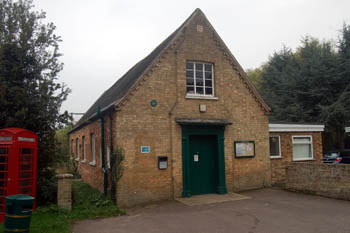Flitton School

The Church Hall October 2010
A directory of 1864 mentions that Mrs. Ann Wheeler was school mistress in the village and it seems likely that this is the first reference to a daily infants' school which must, therefore, have commenced between 1847 (as no such school is mentioned in the national church school survey) and 1864. It probably met in the building later used as the infants' school which is now the church hall on the corner of Brook Lane opposite the church and adjacent to the White Hart public house. It was, presumably, built for the purpose of being a school. The Post Office Directory of 1869 notes that the infants' school mistress was Dinah Downing. There seems to have been a church school in Greenfield from the late 1860s and no doubt older children from Flitton attended it.
The first Education Act was passed in 1870 (more correctly it was known as the Elementary Education Act). It was a milestone in the provision of education in Britain demonstrating central government's unequivocal support for education of all classes across the country. It also sought to secularise education by allowing the creation of School Boards. These were groups of representatives, elected by the local ratepayers and the Board had the powers to raise funds to form a local rate to support local education, build and run schools, pay the fees of the poorest children, make local school attendance compulsory between the ages of 5 and 13 and could even support local church schools, though in practice they replaced them, turning them into Board run schools (known as Board Schools). Naturally, and luckily for local historians, the Act required a questionnaire of local schools in 1870. The return noted that accommodation for fifty infants was required at Flitton and it went on: "If the Flitton Infant School be at once made efficient by providing a gallery and appointing a certificated teacher, no further accommodation will be required".
Kelly's Directory for 1885 mentions an infants' school in Flitton for seventy children with an average attendance of thirty five. Miss Mary Catherine Fennimore was the mistress. The same details are given in the 1894 Kelly's except that average attendance was now down to twenty. The school is not mentioned in Kelly's Directory for 1898 and so the implication is that it closed between 1894 and 1898. The first minute book of Flitton Parish Council dating to 1894 records a meeting in Flitton Schoolroom [PCFlitton1/1]. From 1904 the terms Parish Room and Schoolroom are used interchangeably, with Parish Room becoming the sole designation from 1914 onwards. This probably implies that the Sunday school continued to meet in the old school after its use as an infants' school had ceased.
The Rating and Valuation Act 1925 specified that every building and piece of land in the country was to be assessed to determine its rateable value. The valuer visiting the old school describes it as the Parish Room [DV1/C270/1] which was "used for meetings".